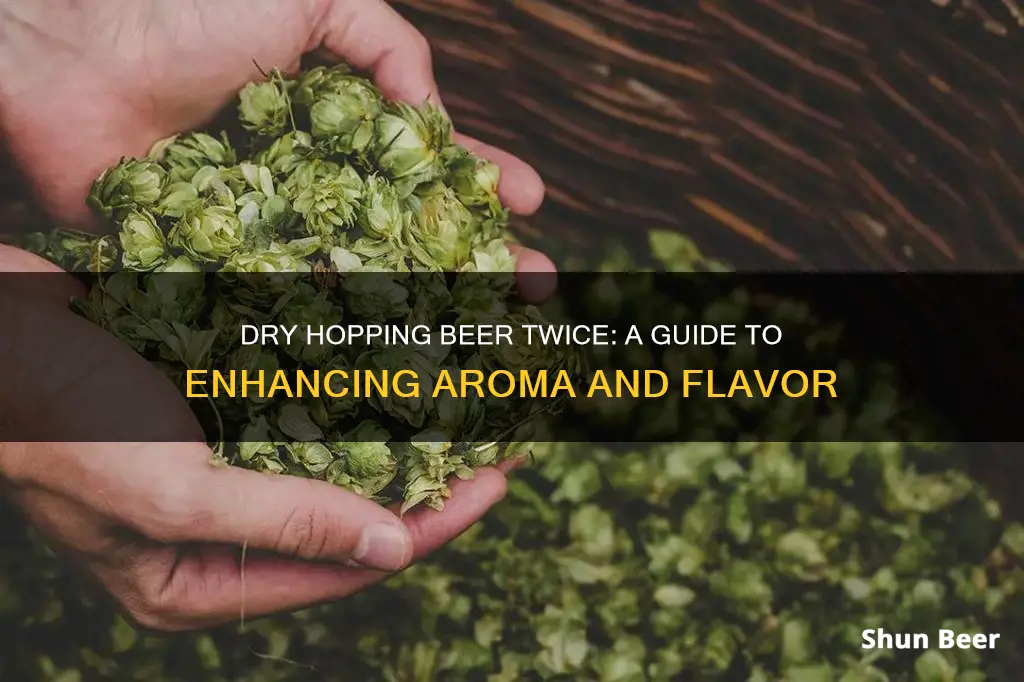
Dry hopping is the process of adding hops to beer during or after primary fermentation. This technique is used to add aroma and flavour without increasing bitterness. The hops can be added to the secondary fermenter or directly to a keg. The hops can be added loose or in a bag. The amount of hops added depends on the desired aroma and the strength of the beer. For a stronger aroma, more hops can be added. The hops can be left in the beer for 3-4 weeks, but the ideal amount of time is 48-72 hours. Double dry hopping involves either splitting the hop additions or using double the amount of hops.
| Characteristics | Values |
|---|---|
| When to dry hop | During secondary fermentation, or after primary fermentation has finished |
| Hop type | Dried whole leaf or T-90 pellets |
| Amount | 1 ounce in 5 gallons of average-strength beer for 10-14 days at 60-70°F |
| Straining | Use a straining bag or strainer to reduce the amount of hops in your beer |
| Sanitation | No need to sanitise dry hops before use |
What You'll Learn

Choosing the right hops
When it comes to choosing the right hops for dry hopping, there are a few key factors to consider. Firstly, it's important to select hops that complement the flavour profile and characteristics of your beer. While there may not be any "wrong" hops to choose, it's generally recommended to use aroma-forward hops for dry hopping. This means opting for hops that are known for their strong aromatic qualities, as the primary goal of dry hopping is to capture and enhance the essential oils in hops that provide aroma and flavour.
Some popular aroma-forward hops to consider include:
- Cascade, which offers a mix of spicy and citrus aromas (such as orange and grapefruit peel)
- Citra, known for its intense grapefruit and lime flavours
- Mosaic, which carries a mango aroma mixed with pine needles and herbal notes
- Nelson, which imparts white wine aromas
- Galaxy, known for its passion fruit notes
- Amarillo, with orange, grapefruit, and citrus aromas
- Simcoe, with citrus and pine notes
- Centennial, a versatile hop with citrus and floral tones
In addition to the specific hop varieties, you can also choose between using whole cone hops, pellet hops, or Cryo Hops®. Whole cone hops are the rustic option, using the whole flowers of the hops as they were harvested. However, they tend to absorb more beer and can dull the extracted aromas. Pellet hops, on the other hand, are the most common and affordable option for homebrewers. They are made by removing the heavier plant parts and pressing the remaining matter into pellets, which absorb less beer and fully surround the particles for better oil extraction. Cryo Hops® are a newer option, made by freezing whole hops and removing the lupulin glands that contain essential oils and acids. This results in a fine powder with a serious punch of aroma and oil, but it is more expensive and may require larger quantities than traditional hops.
When choosing the right hops for dry hopping, it's also essential to consider the timing of the addition. Dry hopping during primary fermentation can lead to unique flavours and aromas through a process called biotransformation, where hop compounds interact with active fermentation. This technique is commonly used for New England-style IPAs (NEIPAs) to achieve a hazy appearance and enhance tropical flavours. Alternatively, dry hopping after fermentation will more reliably produce the aromas described on the hop packaging and is a standard technique for American IPAs.
Hops in Beer and Vinegar: What's the Connection?
You may want to see also

Timing
The timing of your second dry hop will depend on a few factors, including the type of hops you're using, the temperature of your beer, and your personal preference for aroma and flavour.
Dry hopping is typically done during secondary fermentation, as active primary fermentation can scrub out delicate aroma compounds. The secondary fermenter is generally considered the best place for dry hopping because the alcohol content and low pH help to ward off any bacteria on the un-sanitized hops. The vigorous CO2 activity of the primary is also finished, so the aroma of the hops won't be scrubbed out of the beer.
If you're using whole leaf hops, you can add them directly to your beer and siphon them off later. Pellet hops, on the other hand, will disintegrate into a hops sludge that sinks to the bottom, so you'll want to use a straining bag or strainer to reduce the amount of hops in your finished beer.
In terms of timing, hops added to secondary fermentation can add significant levels of aroma within 24 hours, and this will improve for at least 48-72 hours. After that, you'll still get added aroma but not as quickly. Some brewers will leave the hops in for the entire secondary fermentation, but if this is more than a couple of weeks, it can result in vegetal flavours such as grassy notes or other off-flavours.
In general, you won't want to leave the hops in for longer than two to three weeks, as this is when bad flavours will start to develop. So, the ideal amount of time is about 48-72 hours.
It's worth noting that the temperature of your beer will also affect the timing. If you're dry hopping at lower temperatures (40°-50°F), it may take 3-4 weeks to extract the essential oils from the hops.
Ultimately, the final judge of when to remove the beer from the hops should be your nose and taste buds.
Hops in Beer: Necessary or Overrated?
You may want to see also

Dry hopping in the secondary
The secondary fermenter is considered the best place for dry hopping as the alcohol content and low pH help to prevent any bacterial growth on the hops. However, a potential challenge is getting the hops in and out of the fermenter, especially if you are using a glass carboy with a narrow neck. To overcome this, you can use a bucket with a large opening or simply dump the hops into the carboy and separate them from the beer when racking to your bottling bucket or keg.
When dry hopping in the secondary, it is recommended to use a muslin or cheesecloth bag to contain the hops and prevent them from ending up in your glass. While the hops are naturally resistant to bacteria, the bag is not, so it is important to sanitise it before use.
The amount of time you leave the hops in contact with the beer depends on your preference. Hops added to the secondary fermentation can add significant levels of aroma within 24 hours, and this continues to improve for at least 48-72 hours. Leaving the hops in contact with the beer for longer than a couple of weeks may result in vegetal flavours, but some brewers leave the hops in for the entire secondary fermentation.
The type of hops you use is also a matter of preference. You can use whole leaf or pellet hops for dry hopping, although pellet hops tend to disintegrate and sink to the bottom, while leaf hops float on top of the liquid.
Dry Hopping Beer: Contamination Risk or Myth?
You may want to see also

Dry hopping under pressure
To dry hop under pressure, you will need to ferment your beer in a closed, pressurized vessel. This can be done in a keg or a fermentasaurus.
When dry hopping in a keg, it is important to put your dry hops in a hop sock or tea strainer to avoid clogged dip tubes or taps. The hops can be hung using string or allowed to sink to the bottom using sanitized marbles. It is recommended to dry hop at room temperature for around 5 days before chilling to serving temperature.
The fermentasaurus is a pressurized, conical PET fermenting vessel that allows you to choose when to dry hop and make multiple additions. You can dry hop using the yeast collection bottle attached to the bottom of the fermenter or by using a hop sock and magnets to add your hops at any stage of the process.
It is important to note that dry hopping under pressure can be tricky and may result in a foamy mess if not done correctly. It is crucial to depressurize the vessel before opening it to avoid a fountain of beer foam.
Hops to Beer: Acres of Fun and Flavor
You may want to see also

Removing the hops
Using a Bag to Contain the Hops
One method to remove the hops after dry hopping is to use a muslin, nylon, or stainless steel mesh bag to contain the hops. This technique is recommended when dry hopping after fermentation to minimise the introduction of oxygen, which can cause oxidation in the beer. The bag can be easily removed along with the hops when transferring the beer to the serving vessel. It is important to note that using a bag may limit the surface area of the hops in contact with the beer, reducing the hop flavour and aroma. Additionally, sanitising the bag before use is not necessary as the alcohol in the beer will prevent contamination.
Free-Range Hops
Another approach is to allow the hops to roam free in the beer without any containment. This method maximises the contact between the hops and the beer, resulting in better flavour and aroma extraction. However, this technique may be challenging when using carboys or other vessels with small openings, making it difficult to remove the hops.
Timing of Hop Removal
The timing of hop removal depends on various factors, including the desired flavour and aroma intensity, as well as the type of hops used. Typically, dry hopping is done for 3 to 4 days after fermentation is complete. However, some brewers extend this time to up to 2 to 4 weeks, especially when dry hopping at lower temperatures. It is important to use your senses to determine when to remove the hops, as the nose and taste buds can be the best judges.
The Magic of Hops: Unlocking Beer's Bitter Notes
You may want to see also
Frequently asked questions
Dry hopping is the process of adding hops (usually dried whole leaf or T-90 pellets) during or right after primary fermentation. This adds aroma and flavour without any additional bitterness.
Dry hopping is usually done during secondary fermentation as active primary fermentation can scrub out delicate aroma compounds. The ideal time is about 48-72 hours, but you can leave the hops in for up to two weeks before off flavours start to develop.
You can use either whole leaf or pellet hops for dry hopping. Pellet hops are more convenient and readily available, but whole leaf hops will give you better results in terms of beer contact and overall aroma.
For an average amount of aroma, use one ounce of hops per five gallons of average-strength beer. For more hop aroma, or for higher-gravity beers, you can use up to four to five ounces per five gallons.
Using a bag for the hops makes it easier to remove them after dry hopping. However, it can reduce the hops' exposure to the beer, so you may need to use 10-15% more hops if using a bag.







